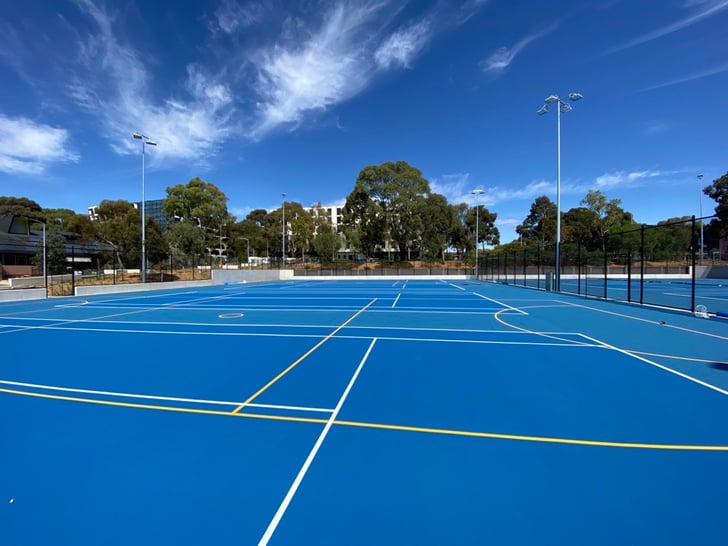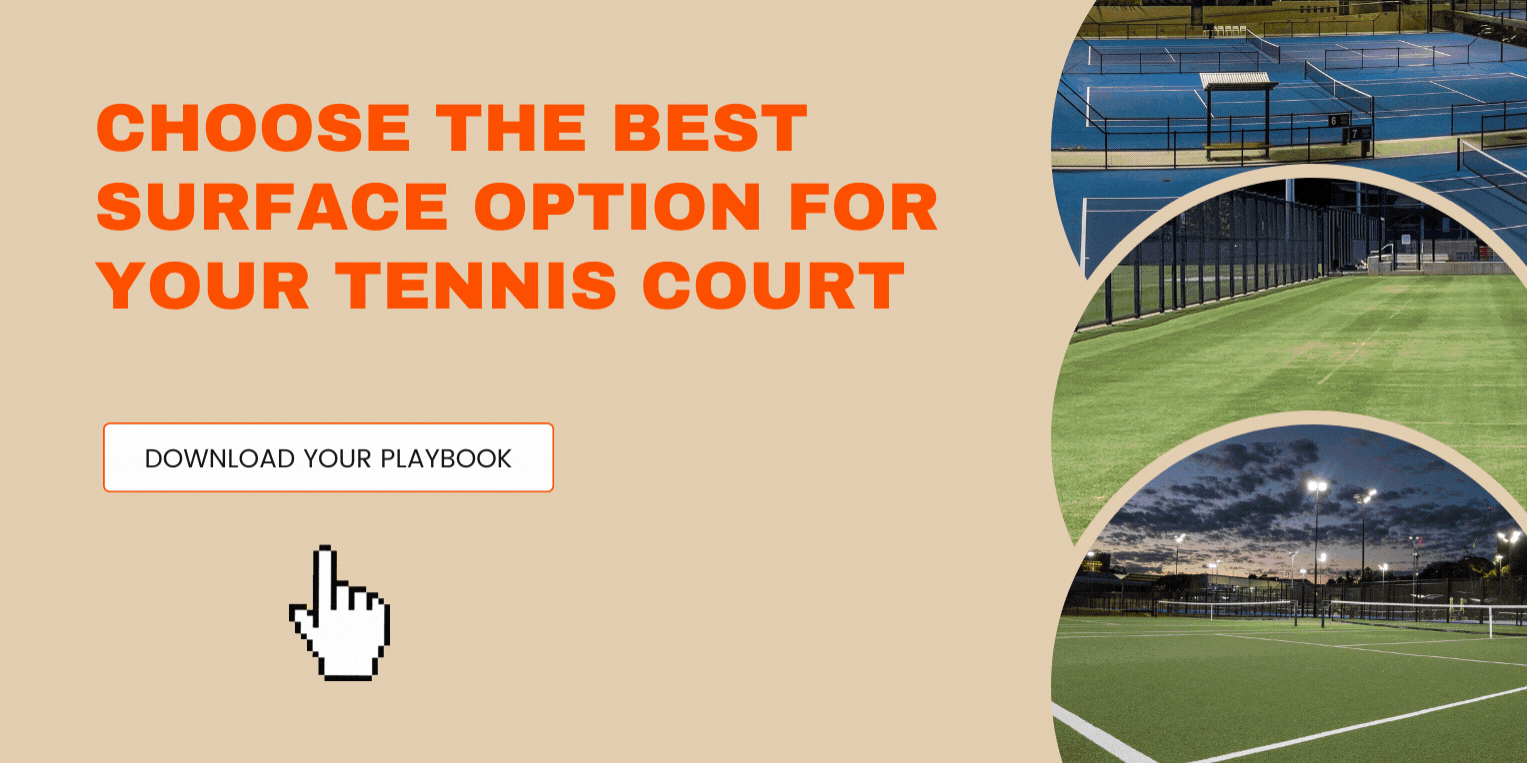Summer in Australia means that tennis season is in full swing and the Australian Open tournament is on our front doorstep. All levels of tennis facilities are given a workout during this time of year and the elite to casual tennis players of the community require access to quality and accessible facilities.
When developing (or redeveloping) a tennis court/s, there is a choice to be made around which type/s of court surface systems will be installed. Generally speaking, there are four court options:
- Natural Grass
- Synthetic Filled
- Acrylic Hard
- Natural Clay / Red Porous
When deciding on the most appropriate surface, the following key drivers should be considered:
- Level of play
- Local weather conditions and environment
- Suitability of ground conditions
- Construction budget
- On-going maintenance requirements
- Life cycle of the surface
- For larger facilities, it is common for multiple surface types to be selected to satisfy all levels and desires of the facility users. In this article, we’ll explore the options above and discuss when each type of surface is suitable for selection.
Natural Grass tennis courts – high maintenance for a premium surface quality
Typically associated with the professional circuit or at larger tennis facilities, natural grass courts do remain a popular choice in some states across Australia. When properly maintained and constructed, natural grass tennis courts offer a premium surface and a unique playing experience for the tennis players.
Their lack of prominence from a community facility perspective is mainly maintenance driven and should only be considered if the facility has access to and implements regular turf management practices. Drainage and irrigation provision are also key aspects of natural turf tennis court facilities and are essential to their successful performance. Natural turf courts can have an overall lifespan of 30+ years, however resurfacing to remove the build of organic matter accumulated in the profile should be done every 7-10 years.
Natural Grass Courts offer fast and low bounce; also, they’re generally considered softer underfoot for the players.
 Natural turf courts at the Memorial Drive, Adelaide - SA
Natural turf courts at the Memorial Drive, Adelaide - SA
Synthetic Filled Systems – the preferred choice at community facilities level
Synthetic Filled Systems typically consist of a tufted synthetic carpet filled with either sand or clay.
Sand Filled Artificial Grass (SFAG) courts are one of the most common types of surfaces at a community facility level. Their appeal is based on numerous factors including playing consistency such as bounce, speed and feel underfoot. SFAG courts also require lower levels of maintenance in comparison to natural grass courts. However, they aren’t maintenance free. Maintenance is required to maintain the infill levels across the court to hold the synthetic fibres upright in order to provide a firm and safe playing surface. SFAG courts don’t offer the same life expectancy as some alterative surface options. Plus, wearing down of the synthetic fibres is common in high-wear areas such as the baseline.
Less common are Sand Filled Artificial Clay (SFAC) courts, which consist of a synthetic turf carpet that is filled with a coloured sand product to mimic the appearance clay tennis courts. The lifespan is similar to that of a SFAG court and also require maintenance to prevent compaction of the sand layers and synthetic grass fibres.
There are numerous products and brands within the synthetic grass industry that offer different outcomes such as level of play, durability, and price – all of which should be considered prior to choosing as specific synthetic grass to suit the needs of the facility and its users.

Synthetic turf tennis court at the Memorial Drive, Adelaide - SA
Acrylic Hard Courts – an elite look and feel for an affordable price
The iconic Melbourne Park is played on a ‘cushioned’ acrylic surface, and it’s this type of surface that most Australians associate high quality tennis with. Similarly, to the synthetic grass products, acrylic surfaces also come in a variety of different types from multiple brands within the tennis industry – so a facility can have an elite look and feel, without breaking the bank.
Acrylic courts require the application of multiple layers of acrylic materials (paint, resin, and silica sand).
Within the acrylic hard-court category, there are two (2) main options:
- Cushioned acrylic
- Non-cushioned acrylic
The main difference between the two options is the presence of a rubber cushioning that improves the impact of the surface on the players body (shock absorption). The cushioning can be provided as a prefabricated roll or as an in-situ poured product. Consistency of bounce and playing consistency is a feature of any acrylic court system and again, is a good option for all levels of players.
Of particular relevance for acrylic systems is the type of engineered base it’s constructed on. For example, liquid applied acrylic system cannot ‘bridge’ over concrete expansion joints, which will lead to cracking in the acrylic surface if the acrylic system isn’t suitable for the engineered base solution. An alternative is an asphalt base (like a road), which doesn’t require expansion joints and all surfacing options can theoretically be applied over the top.
 Acrylic hard tennis courts, Monash University - VIC
Acrylic hard tennis courts, Monash University - VIC
Natural Clay Courts / Red Porous – The elite training facilities option
Prior to the introduction of sand filled systems and acrylic surfaces, the majority of tennis courts in Australia were either porous courts or natural turf. In southern Australia porous courts were typically constructed from en-tout-cas (French term for “in any case” and also being interpreted as for “in any weather”) which consisted of layers of coarse granular material (generally scoria) or a by-product from the manufacturing of bricks. The top layer was a brick dust and subsequent layers would become coarser to help provide a level of integrity while allowing the surface to readily drain through the profile.
Properly constructed natural clay courts, built to replicate the courts found in Spain and France, are often constructed for elite training facilities and consist of imported clays.
Worth noting also is the American clay system. American Clay is made from a harder basalt and not a crushed brick and is often a different colour (green) to the redness of European and Australian clays.
Natural clay courts and red porous courts readily dry out and require frequent watering of the surface to prevent dust being readily created. Due to this reason, parts of Australia aren’t suited to these types of courts unless on-going curating is available to maintain moisture levels.
Whichever way you wish to go, it’s important to understand the maintenance associated with each option and available budget for any on-going replacement works that might be required. Even a Ferrari must be serviced from time to time, so it isn’t a matter of the most expensive and high-end option will be maintenance free. The best option often lies somewhere in between.
Feel free to reach us anytime is you have any questions on this topic. We’ll be more than happy to exchange and share knowledge on such an interesting topic!


